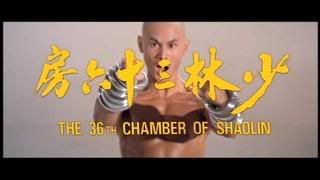
Standard wisdom states that the stories in most kung-fu films are simply bridges to bring you to the next fight. During the late 70s/early 80s it was common for filmmakers to come up with the script as they filmed, leading to some baffling story-lines in between what could sometimes be amazing physical demonstrations. It was the Shaw Brothers films of the 70s that not only introduced higher production values and epic stories to Kung Fu, but also used a stock group of incredibly talented individuals to deliver classic kung fu stories at a furious frequency.
Aside from Chang Cheh (Five Deadly Venoms, Chinese Super Ninjas), Liu Chia-Liang was probably the most accomplished director working out of the Shaw Brother studios. Starting as a fight choreographer for Cheh's films, he soon graduated to directing and began casting his adopted brother Gordon Liu in his films. While he certainly impressed in Executioners From Shaolin (1977), it was The 36th Chamber Of Shaolin (aka Master Killer) which gained both the director and star international prominence.
I remember my first time watching The 36th Chamber Of Shaolin (aka Master Killer) very well. I had recently began to track down the older films of Jackie Chan, and was therefore digging through the kung-fu sections of various video stores. Picking up Master Killer (and, at the same time, Shogun Assassin) must have been divine providence. I (along with my brother) was transfixed from the opening credits, stylized to show Gordon Liu practicing various martial arts styles. It was dubbed, full screen, and jaw-droppingly awesome. It expanded my scope of what a martial arts movie should be, and made me hungry to go outside the Golden Harvest films I had been devouring and open my mind to other Shaw Brothers films.
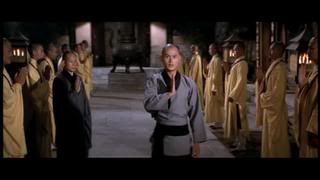
Gordon Liu plays a young student in Canton who joins, along with some fellow students, a local resistance against the brutal invading Tartars. After being discovered, the resistance are brutalized and slaughtered before the injured student escapes to Shaolin to learn kung-fu. The hot headed young man plans to use what he learns to teach the ordinary people of Canton, so they can defend themselves against the invaders. While initially rejected for sneaking into the temple, he is eventually rechristened San Te and allowed to attempt to conquer the 35 chambers of Shaolin. Each represents a physical challenge that opens up San Te's mind while training his body. After a period of many years, he makes his way through each challenge and attempts to create his own chamber, bringing the Shaolin Kung-Fu to the people. He travels back to Canton where he takes on the evil General Tien (Lieh Lo) and shows off his now extraordinary abilities.
The film is most recognized for its trademark training sequences, which went on to influence films from The Karate Kid to The Matrix. In fact, a large portion of the film relies on almost no kung-fu battles, focusing instead on the slow progress that San Te makes through the chambers and the skills he develops. The most famous of these chambers involves the students having to carry water buckets up a narrow ridge, knives strapped beneath their arms to force them to hold their arms straight outwards. Another has San Te holding his head straight between two burning sticks of incense, his eyes focused on a tilting candle to train the young monk to move his eyes rather than his head when fighting an opponent.
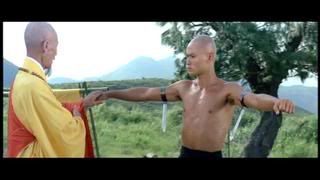
Gordon Liu brings youthful arrogance to the role, often failing at a chamber multiple times before he is able to complete it and move on. The film doesn't labor on these tasks, but gives enough time that we see that there is a slow build to his abilities. When he shows off his kung-fu skills at the end of the film, using a number of techniques we have seen him develop, it's not difficult to believe that he's progressed as far as he has, and he handles the fights very capably, particularly his work with the three-sectioned staff.
Liu Chia-Liang is at the top of his game, bringing a sense of legitimacy to the training and a respect for the trials of San Te. He deftly employs slow motion in key scenes, and employs some memorable tracking shots during the film's fights. Few kung-fu directors could have gotten away with making a two hour film with so few major fight scenes, but the film never slows down and the training sequences are continually fascinating.
The DVD from the Weinstein's slightly offensive Dragon Dynasty series is a revelation. There was some intense criticism from fans for the amount of time this release took (and many, including myself, purchased import versions of the remastered prints being released in China), but the film has simply never looked better. The 2.35:1 is crisp and shows wonderful detail, and while there has been some criticism of the re-mixed sound, it's certainly never distracting.
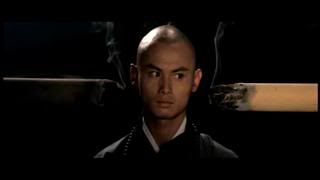
It should be noted that, unlike the import DVDs, this release includes both English subtitles as well as the original English dub track that I first encountered when watching it on video. While i'm a strong proponent of subtitles, the English dub brings back many memories and is a fairly accurate translation.
The disc contains some wonderful special features, including a short (subtitled) conversation with Gordon Liu. He seems in good spirits, and remarkably good shape, and recalls how he got the lead role in the film, as well as his new found fame afterwards. I think it's wonderful that a new generation has discovered Gordon from his parts in both Kill Bill films (as Johnny Mo from the Crazy 88s and Pai Mei) and he's obviously pleased that the film has endured.
We also get short interviews with film critics Andy Klein and David Chute, which gives a bit more insight into the film's place in history. They've also included a short chat with the RZA from the Wu-Tang clan who tells of his experiences watching kung-fu films at the 42nd Street theaters in New York.
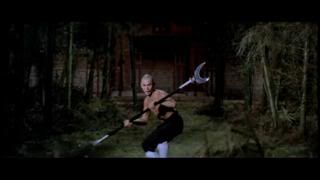
Klein and the RZA return for a full length commentary for the film. It's an interesting mix, and the RZA shows off a surprising knowledge of kung-fu film history while Klein takes a more academic approach to things. RZA's enthusiasm balances Klein's dryness, making it a very worthwhile track.
We're also treated to a stills gallery, a wonderful trailer gallery (featuring trailers for 36th Chamber Of Shaolin, Disciples Of The 36th Chamber, Eight Diagram Pole Fighter, Five Shaolin Masters, Legendary Weapons Of China, Return To The 36th Chamber, and Shaolin Mantis. As well as trailers for the Dragon Dynasty releases of Infernal Affairs 3, Born To Fight, and Seven Swords. Finally, they have included a 17 minute piece on the history of Shaolin entitled Shaolin: A Hero Birthplace.
Perhaps the greatest Kung Fu film ever made, and certainly one of the most influential, The 36th Chamber Of Shaolin remains as vital and entertaining as when it was made. The DVD release gives it the respect and attention it deserves with a stunning transfer and some entertaining extras. For anyone interested in 70s martial arts films, this is your first stop.










No comments:
Post a Comment